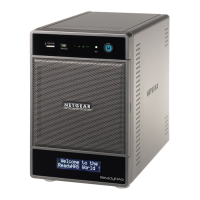Disk Configuration
19
ReadyNAS for Home RAIDiator 4.2
Figure 3 illustrates how X-RAID2 uses new disks.
1
2
3
Figure 3. X-RAID2 disk usage
1. Initial storage space
2. Data protection
3. Additional storage space
With X-RAID2, you do not need to know intricate details about RAID to administer your
system. X-RAID2 allows you to add storage space without reformatting your drives or moving
your data to another location. Because the expansion happens online, you can continue to
use the ReadyNAS while the underlying volume capacity increases.
Flex-RAID
NETGEAR’s Flex-RAID technology allows you to choose from among several
industry-standard RAID levels:
• RAID 0. This is the simplest RAID level, and is misnamed, because it does not offer
redundancy to protect your data from loss in the event that one of your drives fails. RAID
0 distributes data across multiple disks, which allows it to offer better performance than
disks that do not use RAID formatting. The total capacity of your storage system equals
the capacity of all of your disk drives.
• RAID 1. This RAID level provides full redundancy of your data, because it duplicates data
across multiple disks, providing full redundancy. In RAID 1, exactly the same data is
stored on two or more disks at all times. RAID 1 protects your data from loss if one disk
fails. The total capacity of your storage system equals the capacity of your smallest disk.
• RAID 5. Supported on systems with at least four drive bays, this RAID level also provides
data redundancy, but it requires at least three disks. RAID 5 uses one disk to protect you
from data loss if one disk fails. The total capacity of your storage system equals the
capacity of all your disks minus the capacity of one disk.

